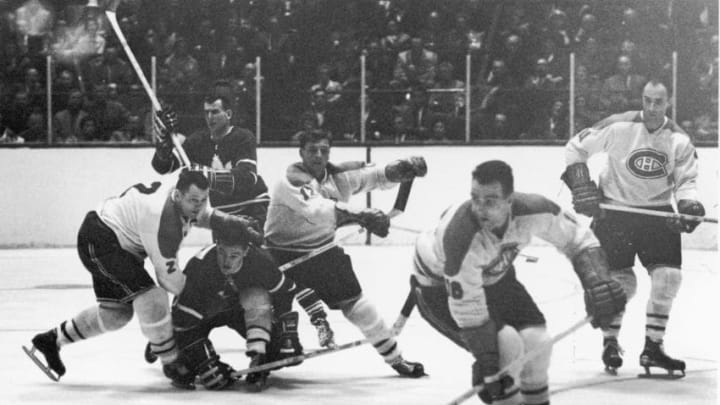What happened on August 23 in the history of the New York Rangers
When a player is inducted into the Hockey Hall of Fame it is supposed to be a joyous occasion. It’s a huge honor and a chance for a retired player to receive the accolades that he deserves. On this date in 1973, defenseman Doug Harvey was inducted into the Hall after a brilliant career in the NHL, mostly with the Montreal Canadiens, but also with the New York Rangers. There was only one problem, he boycotted the ceremony.
One thing about Doug Harvey was that he could bear a grudge. He refused to attend the induction ceremony because he felt that he had been snubbed the prior year when Gordie Howe, Jean Beliveau, and Bernie Geoffrion all entered the Hall. Harvey, as one of the greatest defensemen in NHL history, felt that he deserved to be with that class.
The following year, he was elected to the Hall and that’s when he refused to come to the ceremony. The irony is that it might have just been a misunderstanding. The story is that the selection committee didn’t think that the mandatory three years had passed since he had retired so he was not even considered in 1972, an explanation that seems pretty doubtful since he played his last NHL game on March 29, 1969 for the St. Louis Blues.
Harvey played 19 years in the NHL including two full seasons in New York. He was player-coach in 1961-62 and won the Norris Trophy as the league’s best defenseman that season when he was 37 years old. It was his seventh Norris Trophy, a total surpassed only by Bobby Orr.
He was a controversial figure, not liked by hockey management as he was instrumental in the formation of the first players union. The Canadiens gladly let him go to the Rangers as player-coach in 1961, widely believed because of his unionization efforts. It’s obvious there was an issue, as the Habs did not retire his number until 1985, 12 years after he made it into the Hall of Fame. The Canadiens retired the jerseys of Jean Beliveau, Maurice Richard and Guy Lafleur the same years that they stopped playing.
Harvey is credited as a pioneer in the game, one of the first defensemen to contribute as much offensively as he did defensively. He quarterbacked a Montreal power play that was so good that the NHL had to change the rules and allow the penalized player back on the ice after a goal was scored instead of sitting out the full two minutes.
He was a Ranger for only two full seasons and in his third year he was sent to the minor leagues. He was the first Blueshirt to win the Norris Trophy and one of only four to be so honored. In his one year as coach he led the team to the playoffs for the only time in eight years.
He was a unique figure and his own man and he proved it on this date in Rangers’ history when he decided to go fishing instead of attending his own Hall of Fame induction ceremony.
Today’s birthdays
Only 12 NHL players have been born on August 23 and almost half of them played for the Rangers.
Glenn Healy was born on this date in 1962 in Pickering, Ontario. The goalie is best remembered as a member of the 1994 Stanley Cup team where he served as back up to Mike Richter. He did get into two playoff games in that run to the Cup. Healy played 15 years in the NHL with the Kings, Islanders, Maple Leafs and Rangers. His four years as a Blueshirt were as Richter’s number two.
Carl Hagelin was one who got away. Born on this date in 1988 in Sodertalje, Sweden, he was drafted by the Rangers out of the University of Michigan. He made it to the Rangers in 2011 and was an integral part of the Rangers’ teams that contended for the Stanley Cup, making it to the Final in 2014. A speedy winger, he played on the bottom six and killed penalties, but the Rangers were forced to trade him for Emerson Etem in an effort to get under the salary cap. He is still in the NHL playing much the same role with the Washington Capitals and he won two Stanley Cups with the Pittsburgh Penguins.
Ray Ferraro was born on this date in 1964 in Trail, British Columbia. The center played for the Rangers for most of one season, signing as a free agent after leaving the Islanders. He has bitter memories of his time as a Blueshirt as he had signed with them to stay in the New York area and found himself shipped to Los Angeles in a misguided trade for Jari Kurri. That was one of the worst trade ever by the Rangers. Ferraro was a productive player, appearing in 1,258 games and scoring 408 goals and 898 points for six different teams. He is a familiar face on television as a hockey commentator.
Randy Moller was born on this date in 1963 in Red Deer, Alberta. A defenseman, he was a first round pick by the Quebec Nordiques who was traded to the Rangers after seven years in Quebec in a deal for Michel Petit. He was a Ranger for three seasons before a trade to Buffalo for Jay Wells. He played 13 years in the NHL, finishing his career in Florida in 1995 where he has found a new career as color commentator on Panthers telecasts.
Mike Green was a center, born on this date in 1979 in Calgary, Alberta. No, he is no THAT Mike Green, the defenseman, but was a player who appeared in 24 NHL games in 2003-04 for the Rangers and the Panthers.
